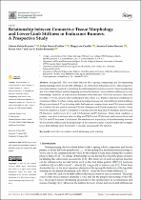Por favor, use este identificador para citar o enlazar este ítem:
https://repositorio.usj.es/handle/123456789/602
Registro completo de metadatos
| Campo DC | Valor | Lengua/Idioma |
|---|---|---|
| dc.contributor.author | Rubio Peirotén, Alberto | - |
| dc.contributor.author | García-Pinillos, Felipe | - |
| dc.contributor.author | Jaén-Carrillo, Diego | - |
| dc.contributor.author | Cartón-Llorente, Antonio | - |
| dc.contributor.author | Abat, Ferrán | - |
| dc.contributor.author | Roche-Seruendo, Luis Enrique | - |
| dc.date.accessioned | 2021-09-10T12:36:12Z | - |
| dc.date.available | 2021-09-10T12:36:12Z | - |
| dc.date.issued | 2021-08-10 | - |
| dc.identifier.citation | Rubio-Peirotén, A.; García-Pinillos, F.; Jaén-Carrillo, D.; Cartón-Llorente, A.; Abat, F.; Roche-Seruendo, L.E. Relationship between Connective Tissue Morphology and Lower-Limb Stiffness in Endurance Runners. A Prospective Study. Int. J. Environ. Res. Public Health 2021, 18, 8453. https:// doi.org/10.3390/ijerph18168453 | es_ES |
| dc.identifier.issn | 1661-7827 | es_ES |
| dc.identifier.uri | https://repositorio.usj.es/handle/123456789/602 | - |
| dc.description.abstract | Background: The lower limb behaves like a spring compressing and decompressing during running, where lower-limb stiffness is one of the most influential factors. This prospective observational study is aimed at examining the relationship between the connective tissue morphology and lower-limb stiffness and investigating whether the barefoot/shod condition influences on such relationship. Methods: 14 male amateur runners (10-km time trial <50’) were included. Data were recorded over one session, where participants ran 2 trials (i.e., barefoot and shod conditions) of 3 minutes at 12 km/h, where running spatiotemporal parameters and vertical (Kvert) and leg stiffness (Kleg) were obtained. Prior to testing trials, thickness and cross-sectional area (CSA) were recorded for Achilles (AT) and patellar tendons (PT) and plantar fascia (PF) with ultrasound. Results: Under barefoot condition, a positive correlation was found between Kleg and AT-thickness and CSA and PF-thickness; and between Kvert and AT-thickness and PF thickness. Under shod condition, a positive correlation was found between Kleg and PT-CSA and PT-thickness, and between Kvert and PT-CSA and PT-thickness. Conclusions: The results reveal a specificity of the relationship between the lower-limb stiffness and the morphology of the connective tissue. Greater tendon shows higher lower-limb stiffness when that tendon is specially demanded by the function. | es_ES |
| dc.format.extent | 10 p. | es_ES |
| dc.format.mimetype | application/pdf | es_ES |
| dc.language.iso | eng | es_ES |
| dc.publisher | MDPI AG | es_ES |
| dc.rights | Atribución 4.0 Internacional | * |
| dc.rights.uri | http://creativecommons.org/licenses/by/4.0/ | * |
| dc.subject | Foot behavior | es_ES |
| dc.subject | Tendon | es_ES |
| dc.subject | Stretch-shortening cycle | es_ES |
| dc.subject | Running | es_ES |
| dc.title | Relationship between connective tissue morphology and lower-limb stiffness in endurance runners. A prospective study | es_ES |
| dc.type | info:eu-repo/semantics/article | es_ES |
| dc.identifier.doi | 10.3390/ijerph18168453 | es_ES |
| dc.rights.accessrights | info:eu-repo/semantics/openAccess | es_ES |
| Aparece en las colecciones: | Artículos de revistas | |
Ficheros en este ítem:
| Fichero | Descripción | Tamaño | Formato | |
|---|---|---|---|---|
| Relationship between connective tissue morphology.pdf | 574,57 kB | Adobe PDF |  Visualizar/Abrir |
Este ítem está sujeto a una licencia Creative Commons Licencia Creative Commons

